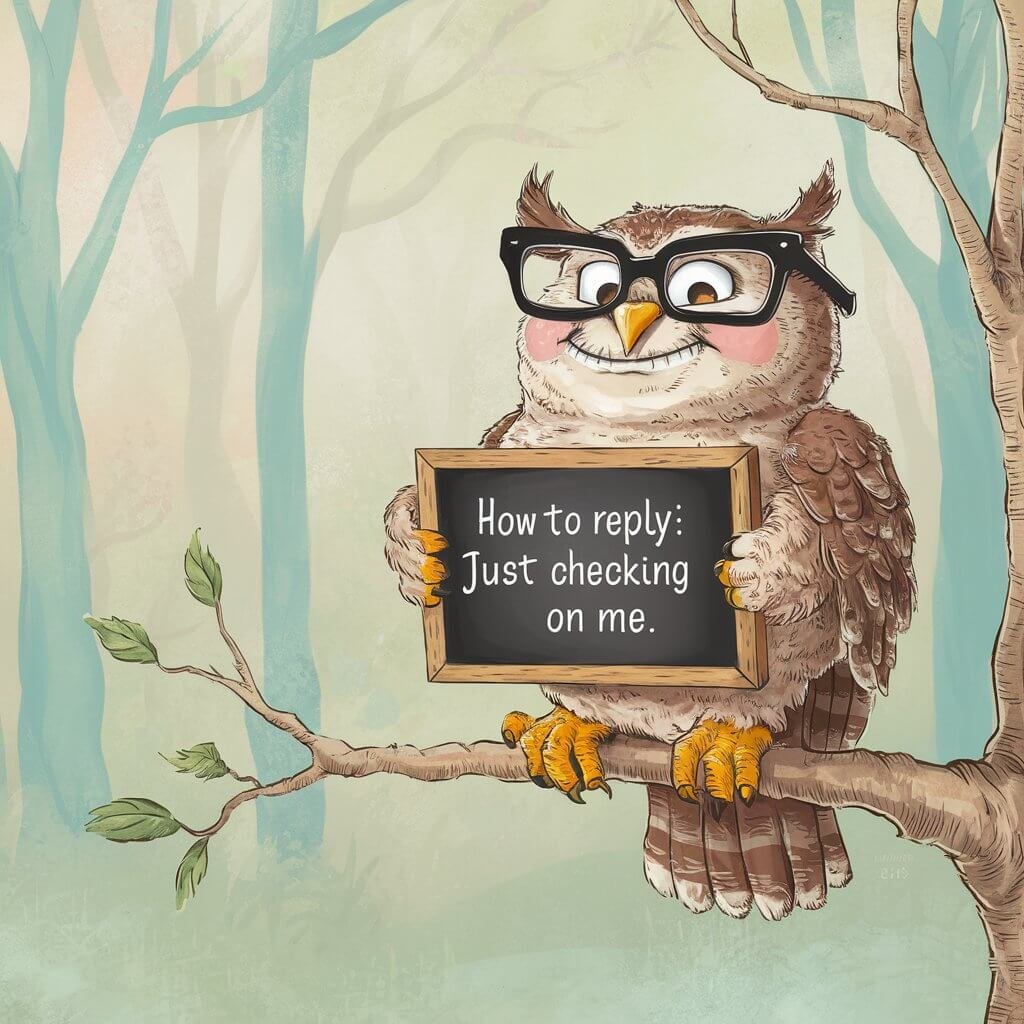
**How to Reply Just Checking on Me** Reply with a simple, “Thanks for checking in. I’m doing well.” This shows appreciation and gives a brief update.
People often check in to show care and maintain connections. Responding effectively can reinforce relationships and provide reassurance. A concise response like, “Thanks for checking in. I’m doing well,” acknowledges their concern without overwhelming them with details. Such replies create a positive interaction, making the person feel valued.
This approach encourages ongoing communication and strengthens bonds. Always aim for sincerity in your response to keep the conversation genuine. By keeping it brief and appreciative, you ensure the exchange remains pleasant and meaningful.
The Art Of Acknowledgment
Knowing how to reply to someone checking on you is important. It shows you care. It builds connections and trust. Let’s explore the best ways to respond.
Why Replies Matter
Replies matter because they show you value the other person. They help keep relationships strong. Ignoring messages can hurt feelings. Always acknowledge someone reaching out.
The Impact Of A Thoughtful Response
A thoughtful response makes a big impact. It shows you are considerate. It helps in strengthening bonds. Here are some tips on crafting a good reply:
- Be sincere. Say what you truly feel.
- Express gratitude. Thank them for checking on you.
- Share how you are. Give a brief update on yourself.
- Ask about them. Show interest in their well-being.
Here is a table with examples:
| Text | Response |
|---|---|
| Just checking on you! | Thank you! I’m doing well. How about you? |
| Are you okay? | I appreciate your concern. I’m fine. How are you? |
Assessing The Intent
Understanding the intent behind a “just checking on me” message is crucial. It can help you craft an appropriate and thoughtful response. This section explores how to decode the message and understand the relationship to assess the true intent.
Decoding The Message
Messages can have different meanings based on their wording. Analyze these elements:
- Tone: Is the message formal or casual?
- Timing: Was the message sent at a specific time?
- Frequency: How often do you receive such messages?
These factors help determine if the sender is genuinely concerned or making a casual conversation. For instance, a concerned friend might check in late at night. In contrast, a casual acquaintance may send a message during the day.
Understanding The Relationship
The nature of your relationship with the sender plays a key role. Consider these aspects:
| Relationship Type | Possible Intent |
|---|---|
| Close Friend | Genuine concern for your well-being |
| Colleague | Professional curiosity or casual check-in |
| Acquaintance | Basic courtesy or small talk |
A close friend likely cares deeply about your health. A colleague might be checking on a project status. An acquaintance may simply want to maintain social niceties.
Crafting A Quick Reply
Sometimes, you receive a “just checking on me” message. Responding quickly is important. Here, we’ll explore how to craft a quick reply.
Keeping It Brief
Short replies are often best. They show you care while saving time.
- Thank the person: “Thanks for checking on me!”
- Update them: “I’m doing well, thanks!”
- Express appreciation: “I appreciate your concern.”
Use simple sentences. This ensures your message is clear.
Using Templates Effectively
Templates can save you time. Here are a few examples:
| Template | Example |
|---|---|
| General Reply | “Thanks for checking on me! I’m doing okay.” |
| Busy Reply | “Thanks! Busy right now, but all good.” |
| Personal Touch | “Your message made my day! I’m good, thank you.” |
Customize these to fit your style. This makes your reply feel personal.
Personalizing Your Response
Personalizing your response can make it more meaningful and heartfelt. It shows you care and value the relationship. Here are some ways to add a personal touch and reference past interactions.
Incorporating A Personal Touch
Adding a personal touch makes your reply unique. Use the person’s name in your response. This shows you are thinking about them specifically. For example:
Hi Sarah, thank you for checking on me!
Share something personal about your day or feelings. This can make the conversation more engaging. You might say:
Hi Sarah, thank you for checking on me! I had a busy day but I’m feeling better now.
Express gratitude for their concern. It makes your response warm and appreciative. For example:
Hi Sarah, thank you for checking on me! Your concern means a lot to me.
Referencing Past Interactions
Referencing past interactions can strengthen your connection. Mention a recent event or conversation. This shows you remember and value your interactions. For example:
Hi Sarah, thank you for checking on me! I enjoyed our chat last weekend.
Recall shared experiences to create a sense of continuity. This can make your response more relatable. You might say:
Hi Sarah, thank you for checking on me! Remember our trip to the beach? It was so fun!
Highlight mutual interests or plans. This keeps the conversation going and shows you care about your shared activities. For example:
Hi Sarah, thank you for checking on me! Looking forward to our movie night next Friday!
Expressing Gratitude
When someone checks in on you, expressing gratitude is crucial. It shows appreciation and strengthens your relationship. Here’s how you can do it effectively.
The Power Of Thank You
A simple “Thank you” goes a long way. It makes the person feel valued. Let’s explore why this phrase is powerful.
- It acknowledges their effort.
- Makes them feel appreciated.
- Strengthens your bond.
Use “Thank you” often to show you care. It’s a small gesture with a big impact.
Creative Ways To Show Appreciation
Sometimes, words are not enough. Here are some creative ways to show appreciation:
| Method | Description |
|---|---|
| Handwritten Note | Write a personal note saying thank you. |
| Small Gift | Give a small token of appreciation. |
| Public Praise | Thank them publicly on social media. |
Choose a method that fits the situation best. Sometimes, a small gesture means a lot.
Finally, remember to be sincere. Genuine appreciation builds strong connections. Never underestimate the power of a heartfelt thank you.
Offering Reciprocity
When someone checks on you, it’s kind to offer reciprocity. Offering reciprocity helps build stronger connections. Show your appreciation and maintain the bond.
Extending The Check-in
After someone checks on you, extend the same kindness. Ask how they are doing. Show genuine interest in their well-being.
Here are some phrases to use:
- How have you been?
- Is everything okay with you?
- What’s new in your life?
Use these phrases to show you care. This encourages a deeper conversation.
Proposing Future Engagement
Propose future engagements to keep the connection alive. Suggest activities you both enjoy.
Here are some ideas:
- Let’s catch up over coffee soon.
- How about a walk in the park?
- Would love to grab lunch sometime.
These suggestions show you value their friendship. It also sets up a future meet-up.
Navigating Professional Etiquette
Navigating professional etiquette can be tricky, especially in a work environment. Responding to a “just checking on me” message requires a balance. You need to be professional and warm. The following sections will guide you through the nuances of replying in a work context.
Replying In A Work Context
In a work setting, responses should be clear and concise. Always start with a polite greeting. For example, you could say, “Hello [Name], thank you for checking in.” This shows appreciation and maintains professionalism.
Next, address the query. If everything is on track, you might say, “Everything is going well with the project.” If there are issues, be honest but concise: “We are facing some delays, but we are working on it.”
Conclude your message with a polite closing. For instance, “Thank you for your concern. Best regards, [Your Name].” This ensures the conversation ends on a positive note.
Balancing Formality And Warmth
Balancing formality and warmth is key in professional replies. Being too formal can seem distant. On the other hand, being too informal might appear unprofessional.
| Formal Phrase | Warm Phrase |
|---|---|
| Good afternoon | Hi there |
| Best regards | Take care |
Use a mix of both formal and warm phrases. For example, “Good afternoon, [Name]. Thanks for checking on me. Everything is on track. Take care, [Your Name].” This mix keeps the tone professional yet friendly.
Keep sentences short and easy to understand. Avoid jargon or complex words. This ensures your message is clear and approachable.
Remember, the goal is to maintain professionalism while showing warmth. This approach fosters a positive work environment and effective communication.
Avoiding Common Pitfalls
Responding to “just checking on me” messages can be tricky. You need to avoid common pitfalls to ensure your reply is appropriate and well-received. Here are some tips to help you respond effectively.
Overlooking The Message
Ignoring the message can seem rude. Always acknowledge the sender’s concern. A simple reply like “Thanks for checking on me” works well.
Here’s a table to show different ways to acknowledge:
| Situation | Response |
|---|---|
| Feeling fine | “I’m doing well, thanks for checking!” |
| Feeling down | “Not great, but thanks for checking on me.” |
| Busy | “I’m busy but I appreciate you checking in.” |
Being Too Casual Or Too Formal
Balance your tone based on your relationship with the sender. Being too casual might seem dismissive. On the other hand, being too formal can feel distant.
Use these tips:
- If it’s a friend, say: “Hey! Thanks for checking in!”
- If it’s a colleague, say: “Thank you for reaching out.”
Avoid phrases like “Yo, what’s up?” with colleagues. Also, don’t say “Dear Sir/Madam” to friends. Tailor your response to the relationship’s context.
Embracing Digital Communication
Digital communication has become a vital part of our lives. We connect with friends and family through messages and social media. Responding to a “Just Checking on Me” message is important. It shows we care and keep relationships strong.
Choosing The Right Medium
Choosing the right medium is crucial for your reply. Different platforms offer different benefits. Text messages are quick and personal. Emails are formal and allow for detailed responses. Social media messages are casual and fun.
| Medium | Best For |
|---|---|
| Text Messages | Quick, personal replies |
| Emails | Detailed, formal responses |
| Social Media | Casual, fun interactions |
Timing Your Reply
Timing your reply is just as important. Responding quickly shows you care. It also makes the other person feel valued. If you need time to think, let them know. A simple “I’ll get back to you soon” works well.
- Reply quickly to show you care.
- If busy, inform them you’ll reply soon.
- Avoid long delays in your response.
Conclusion: The Ripple Effect Of Replying
Replying to a “Just checking on me” message creates a ripple effect. It strengthens relationships and spreads kindness. This simple act can have profound impacts on both parties.
Strengthening Connections
Responding to these messages shows you care. It helps build trust and deepens friendships. A quick reply can transform casual acquaintances into close friends.
Benefits of Strengthening Connections:
- Improves emotional well-being
- Builds a support network
- Enhances mutual respect
Engaging in these small conversations makes people feel valued. A simple reply can brighten someone’s day.
Encouraging Kindness
Your response can inspire others to act kindly. When you reply, you set an example. People are more likely to check on others.
Ways to Encourage Kindness:
- Reply promptly
- Express genuine concern
- Offer help if needed
Kindness spreads through actions. Each reply you send is a step towards a more compassionate world.
Frequently Asked Questions
How Do You Text “Just Checking On You”?
Text “Just Checking On You” by sending: “Hey, just checking in. How are you doing? ” This message is simple and caring.
What Can I Say Instead Of Just Checking On You?
“How are you doing? ” “Is everything okay? ” “How have you been? ” “Just wanted to see how you’re feeling. “
How Do You Respond To Just Want To Check In?
Sure, how can I assist you today?
Do You Say Thank You For Checking On Me?
Yes, saying thank you for checking on me is polite and appreciated. It shows gratitude and strengthens relationships.
Conclusion
Acknowledging a “just checking on me” message shows care and strengthens relationships. Use these tips to respond thoughtfully. Remember to be genuine and considerate. By doing so, you’ll foster deeper connections and show appreciation for their concern. Your thoughtful replies can make a significant difference.

